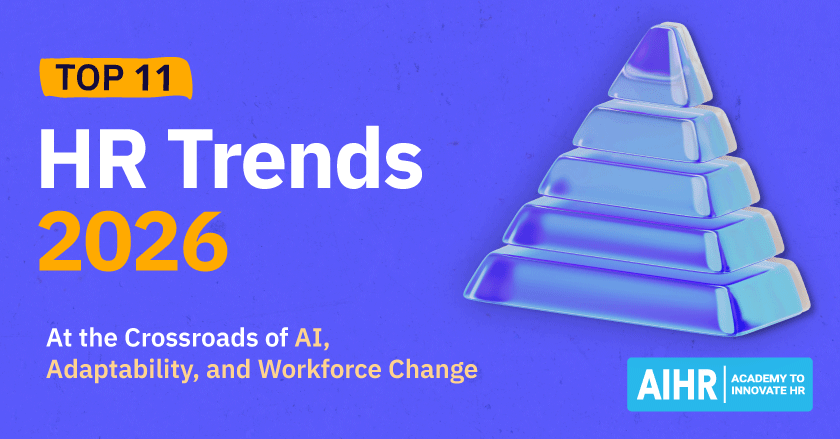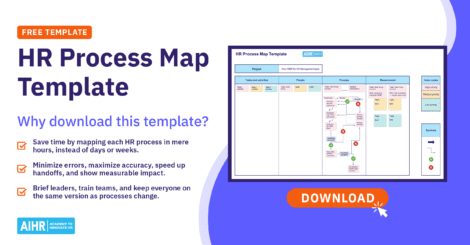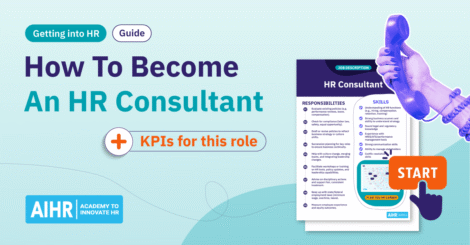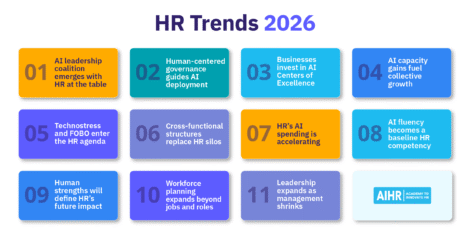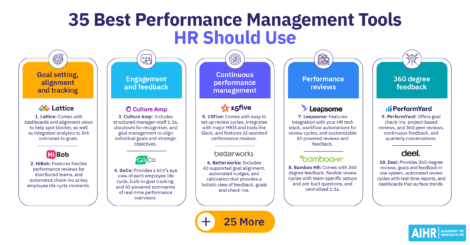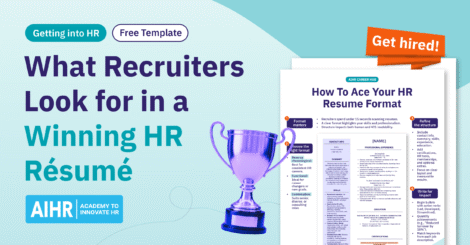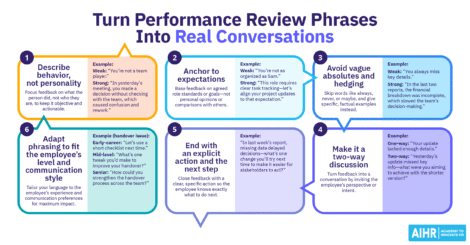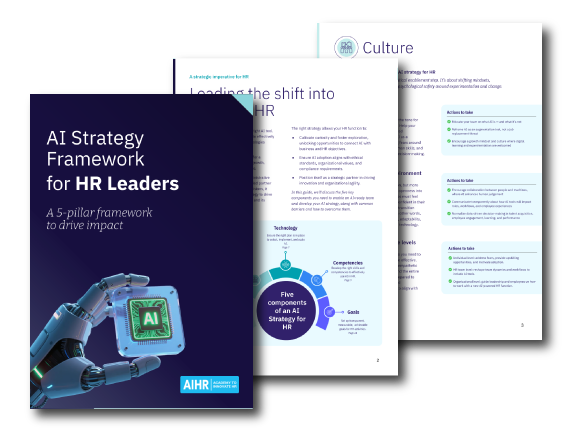Statistics show how much pressure HR is under to do more with less. While other departments like Marketing and Operations often grow as business priorities expand, HR remains lean, typically representing only 2% of total staff. This means HR is expected to deliver culture change, digital transformation, and strategic impact without the resources of other functions.
For practitioners, the numbers are a reminder that proving value, building new capabilities, closing skills gaps, finding smarter ways to integrate technology, and turning strategy into measurable outcomes are the key to staying credible and influential in the business.
Contents
Theme 1: The state of the HR function
Theme 2: Skills and capabilities in HR
Theme 3: The strategic role of HR
Theme 4: The evolving HRBP model
Theme 5: AI and technology in HR
Theme 6: Leadership and the CHRO role
Why these HR statistics matter
What the numbers tell us to do
Theme 1: The state of the HR function
The State of HR report highlights how HR remains one of the smallest functions in organizations, facing scaling limits, capability gaps, and unstructured career paths that weaken its long-term talent pipeline.
Key statistics
- Investment and size: HR represents only 2% of employees, compared to Marketing (7%), Operations (9%), and Administration (15%). Growth peaks at about 2.3% for organizations between 500 and 5,000 employees, and stagnates afterward, which shows structural limits to scaling.
- Readiness and capability: 83% of HR professionals feel confident in execution and transactional work, but only 64% feel confident in translating strategy and applying financial data in decision-making. This highlights a gap between operational reliability and strategic impact.
- Skills signals: HR job postings continue to emphasize administration, communication, and compliance, while underrepresented but critical areas include digital skills, commercial fluency, and data literacy.
- Career pathways and development: HR careers are often unplanned. 72% percent of professionals enter HR before age 30 after working in other disciplines, and many start HR as their second, third, or even fourth job. Success is defined differently across the profession: 23% value making a meaningful impact on work and society, while 40% prioritize their own professional growth and development.
What this means for HR
HR continues to face challenges linked to its small size and limited investment. With only 2% of the workforce, the function struggles to scale and often operates as a headquarters-based unit, which reduces its visibility and impact across organizations.
Confidence is heavily tilted toward execution, leaving gaps in strategic translation and financial decision-making. This reinforces the image of HR as operational rather than strategic. At the same time, job postings and development priorities remain focused on generic skills, while digital, data, and commercial capabilities are underdeveloped.
Careers in HR are also frequently unstructured, with many professionals entering the field by chance. This lack of intentional career development weakens the talent pipeline and slows the build-up of the skills needed for HR’s future role.
Action points
- Restructure investment: Reassess HR team size and operating models to align resources with organizational growth and complexity.
- Shift skills focus: Prioritize upskilling in digital adoption, data use, and commercial fluency, rather than overinvesting in generic competencies. For example, AIHR’s Digital HR 2.0 Certificate Program helps HR professionals develop digital and HR automation skills to boost innovation, efficiency, and performance.
- Strengthen strategy alignment: Involve HR professionals more directly in strategic and digital conversations, ensuring they can translate business needs into measurable HR outcomes.
- Formalize career development: Create structured pathways and upskilling initiatives to make HR careers more intentional and attractive, building a stronger long-term talent pool.
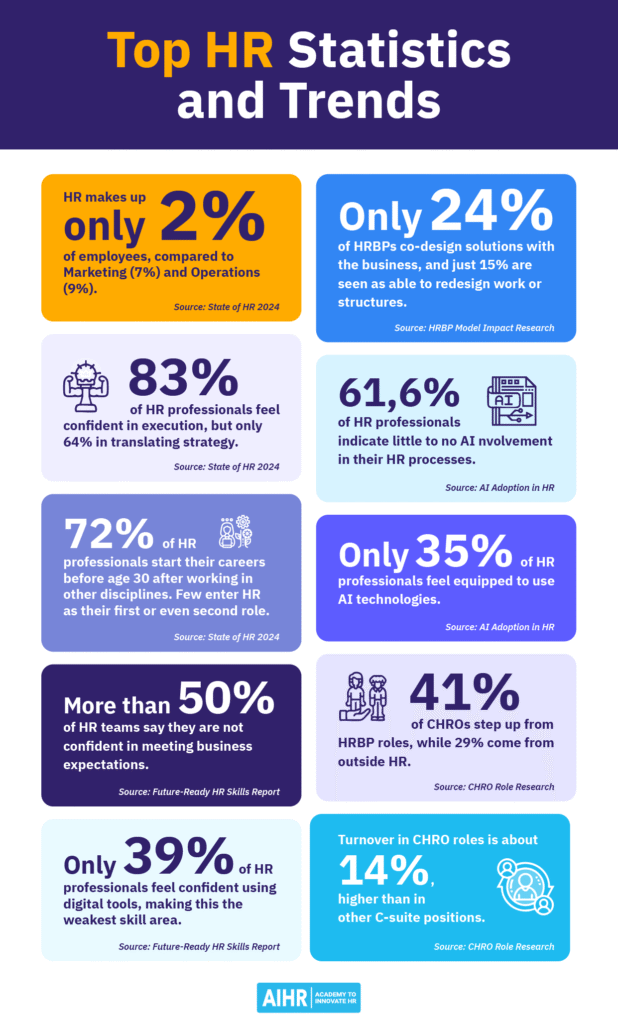
Theme 2: Skills and capabilities in HR
The Future-Ready HR Skills Report shows that while confidence in HR skills is often high, actual capability lags behind. Business acumen, data literacy, and digital agility emerge as the most pressing areas to strengthen.
Key statistics
- Business acumen: 73% of HR professionals feel confident in their business acumen, but commercial fluency is consistently the weakest subskill. It’s important to note that confidence doesn’t always translate to capability. Those in strategy-facing roles score far higher than practitioners in service roles.
- Data literacy: 60% of HR professionals feel confident in their ability to understand and translate data. However, storytelling and translation subskills score lowest across all levels, showing that most HR teams still struggle to turn data into actionable insights.
- Digital agility: Only 39% of HR professionals feel confident in using digital tools, making this the lowest-rated skill area. Seniority does not improve results, and many still struggle to choose the right tools for the right problems.
- People advocacy: 74% of HR professionals feel confident leading with values, especially in areas of wellbeing and culture. However, they fall behind in risk navigation and ethics, with service roles lagging behind advisory and coaching roles.
- Execution excellence: 82% of HR professionals feel confident in their ability to execute, with strengths in interpersonal engagement and problem-solving. The gap lies in analytical problem-solving, where many strong executors still fall short.
What this means for HR
The report makes it clear that confidence is not the same as capability. HR professionals often overestimate their proficiency in areas like business acumen and data use, while the real gaps lie in commercial fluency, data storytelling, and digital adoption. These weaknesses limit HR’s ability to act as a strategic partner and to fully integrate technology and data into decision-making.
At the same time, HR excels in areas like execution and people advocacy, which reinforces its role in culture and delivery. But without strengthening digital, analytical, and commercial skills, the profession risks remaining too operational and falling short of business expectations in a rapidly changing environment.
Action points
- Build broad and deep skills: Move away from isolated training and design development that strengthens both core expertise and cross-domain fluency.
- Focus on fundamentals: Prioritize essential skills like commercial fluency, analytics translation, and digital decision-making, as these are now baseline expectations for strategic HR.
- Design with exposure in mind: Create learning experiences tied to real work, such as cross-functional projects and applied analytics, rather than relying on generic training.
- Understand real capability: Diagnose team strengths beyond job titles or seniority to uncover hidden gaps and target development more effectively.
Build the skills to meet HR’s biggest challenges
The numbers don’t lie: HR is being asked to deliver more with fewer resources. Limited headcount, rising expectations, and fast-moving technology mean the future belongs to HR teams that can upskill fast, work smarter, and prove their impact.
With AIHR’s Full Academy Access, you and your team will:
✅ Gain unlimited access to 40+ HR certificate programs and courses across every strategic and operational HR area
✅ Build in-demand skills in digital HR, people analytics, talent management, and leadership
✅ Learn to translate HR strategy into measurable business outcomes
✅ Close capability gaps and stay ahead of trends like AI and workforce automation
🎓 Future-proof your HR function and your career with one all-inclusive learning membership.
Theme 3: The strategic role of HR
Findings from the HR Strategy Research emphasize that strong HR strategies go beyond simply mirroring business goals. Execution quality and the balance between inside-out and outside-in perspectives determine whether strategies truly deliver impact.
Key statistics
- Strategies beyond business alone: Top HR strategies don’t just mirror the business plan. The most successful companies incorporate external factors — market trends, industry shifts, social issues — into HR strategy, ensuring it’s responsive both internally and externally.
- Inside-out vs outside-in focus: Organizations often orient their HR strategy around either internal processes (employee experience, culture, development) or external positioning (employer brand, external reputation, relationships with labor markets). The clearest strategies explicitly define which side they lean toward.
- Execution differentiates success: Many successful companies have the same strategic focus areas (like DEIB, engagement, ESG), but they distinguish themselves in how they execute those initiatives—by aligning execution tightly with business context and choosing different operational levers based on strategy orientation.
- Underinvestment in HR strategy: Even among high performers, HR strategy is often under-resourced. That limits the ability to sustain the strategic role of HR over time.
What this means for HR
HR strategies need to go beyond aligning with business plans and also account for external factors like market shifts and social trends. Balancing inside-out elements, such as employee experience, with outside-in perspectives helps leaders make more deliberate choices.
Success also depends on execution. Clear priorities, resource allocation, and embedding initiatives into the HR value chain are what turn strategy into impact.
A recurring challenge is underinvestment. Even strong strategies falter if HR lacks the funding, skills, or time to carry them out effectively.
Action points
- Define strategic orientation: Explicitly choose whether your HR strategy will lean inside-out, outside-in, or strike a balance. Use that to guide which initiatives get priority.
- Clarify and embed execution plans: Don’t leave strategy at the conceptual level. Translate it into detailed operational plans within HR’s value chain (talent, development, operations).
- Measure meaningfully: Choose metrics that connect HR actions to business outcomes and monitor how strategic initiatives perform over time.
- Secure resources for strategy: Embed the required investment (skills, tools, time) in your HR strategy from the start, not as an afterthought.
Theme 4: The evolving HRBP model
Insights from the HRBP Model Impact Research reveal that many organizations still struggle to connect HR strategy with measurable business outcomes, with HRBPs often underpowered to co-design or redesign work alongside the business.
Key statistics
- Co-design and redesign capability: Only 24% of organizations report that HRBPs actively collaborate with business leaders to design solutions. Just 15% believe HRBPs are equipped to redesign work structures or frameworks.
- Strategy to impact gap: While 76% of respondents rate their HR strategy as a strength, only 56% believe it produces measurable business impact.
- Execution alignment challenges: Just 55% of HR teams feel their structure supports strategy, and 42% lack confidence in their systems and processes to deliver. Digital agility is also a concern, with only 37% feeling confident in technology use and many reporting uncertainty in data literacy and evidence-based practices.
What this means for HR
Many HRBP models spend too much energy on design without translating strategy into measurable outcomes. Organizations often succeed in aligning HR goals with business priorities, but they fall short in connecting HR work to business performance. This weakens trust with executives and makes it difficult to secure long-term investment.
Execution remains a key challenge. Even when structures appear supportive, weak systems, unclear accountability, and limited authority keep HRBPs from operating as true business partners. This often leaves HR reacting to needs instead of shaping them.
The report also highlights capability gaps. Without strengthening digital agility, data literacy, and commercial fluency, HRBPs cannot fully deliver on their role as strategic partners.
Action points
- Connect strategy to outcomes: Define HR’s value in terms of business results, not just HR activities.
- Strengthen execution systems: Improve processes, clarify decision rights, and build infrastructure that enables HRBPs to deliver impact.
- Focus on future capabilities: Invest in skill-building for digital, analytical, and commercial expertise to close gaps that weaken the HRBP model.
- Build HRBP expertise: Enroll in AIHR’s HR Business Partner 2.0 Certificate Program to develop the commercial, analytical, and digital skills needed to evolve into a trusted strategic partner.
Theme 5: AI and technology in HR
The AI Adoption in HR study illustrates that while professionals are optimistic about AI, adoption remains cautious. Most usage is limited to low-risk, individual tasks, with significant barriers around trust, skills, and proving value.
Key statistics
- AI involvement: 61.6% of HR professionals report little to no AI involvement in their HR processes.
- AI readiness: Only 35% feel equipped to use AI technologies, highlighting a clear skills gap.
- AI upskilling: 38% of professionals say they are developing their skills through self-exploration of AI tools.
- Adoption pattern: Most current use remains small-scale and focused on individual productivity, rather than integrated across HR functions.
What this means for HR
AI adoption in HR is still fragmented. While enthusiasm is high, most professionals have limited involvement with AI and rely on vendor-driven tools in recruitment. Confidence and readiness to use AI remain low, with many HR professionals teaching themselves rather than receiving structured training. This shows both the appetite for experimentation and the lack of systematic investment in building AI capability.
Action points
- Invest in AI skills: Move beyond self-exploration by offering structured training so HR teams feel equipped to apply AI responsibly.
- Integrate across HR: Expand adoption from isolated tasks to connected applications across the employee lifecycle.
- Measure business outcomes: Tie AI initiatives to metrics like efficiency, time-to-hire, or retention to demonstrate impact and secure investment.
- Build governance and trust: Put frameworks in place for ethical use, data privacy, and responsible decision-making.
- Upskill with AIHR’s Artificial Intelligence for HR Certificate Program to build confidence and apply AI effectively in HR.
Theme 6: Leadership and the CHRO role
The CHRO Role Research points to a position that is broader and more complex than ever. Career pathways into the role are diverse, turnover is higher than in other C-suite positions, and responsibilities now stretch far beyond HR operations.
Key statistics
- Internal barriers to CHRO success: Only 40% of senior HR leaders say they have the ambition to become CHROs. Many cite internal challenges such as power dynamics, politics, legitimacy, and the burdens of navigating complex stakeholder environments.
- Career paths into the CHRO role: About 41% of CHROs advance from HRBP positions, while 29% come from outside HR.
- Turnover and promotion rates: Top HR roles see turnover of about 14%, which is higher than in other C-suite roles. Promotion rates into CHRO are relatively low, with only 57% coming from internal promotion paths.
- Expanded role scope: The CHRO’s role has shifted from head of HR to full business leadership, covering ESG, digitalization, and broad stakeholder management (board, C-suite, industry).
What this means for HR
Ambition to take on the CHRO role is limited, and the path is fraught with internal challenges. Many capable HR leaders may shy away because they expect the role to be politicized, lonely, or lacking in legitimacy. The fact that only 40% of senior HR leaders want the CHRO role underscores that perception gap.
Getting into the CHRO role is rarely straightforward. While many CHROs come from HRBP backgrounds, a significant share arrives from outside HR, which points to varied skills and experiences. The higher turnover and lower promotion rates compared to other C-suite roles imply that structural issues exist around succession planning, credibility, and support.
Today’s CHRO is no longer confined to leading HR operations. They must lead with a business mindset across ESG, digital, and stakeholder management domains. That demands a broader skill set, more visibility, and legitimacy at the executive level.
Action points
- Enhance CHRO pathways: Develop clearer succession planning and exposure into business roles so HR leaders can see and prepare for CHRO responsibilities.
- Strengthen internal legitimacy: Equip potential CHROs with influence, executive presence, and ability to navigate politics and structures.
- Broaden capability development: Build skills in ESG, digital leadership, stakeholder influence, and strategic business thinking.
Why these HR statistics matter
Across skills, strategy, technology, leadership, and investment, one theme stands out: HR is being asked to advance faster than it is equipped to. These statistics are not just numbers in a report. They show where the function is doing well, where the cracks are showing, and where action is needed.
- Skills: More than half of HR teams say they are not confident they can deliver on business expectations. Weaknesses in digital agility and data literacy are especially critical, as they limit HR’s ability to operate effectively in an AI-driven workplace.
- Strategy: Around three out of four leaders consider their HR strategy strong, yet only just over half believe it has a measurable business impact. Without evidence of outcomes, HR struggles to influence or secure investment.
- Technology: Interest in AI is high, but adoption is still uneven. Most use is limited to small-scale, individual tasks, while broader integration across HR functions remains rare.
- Leadership: The CHRO role has expanded to include ESG, digitalization, and wider stakeholder management. Turnover in this role is higher than in other C-suite positions, showing how demanding and volatile it has become.
- Investment: HR remains one of the smallest functions, making up about 2% of headcount compared to 7% in Marketing and 9% in Operations. Expectations continue to grow faster than available resources.
What the numbers tell us to do
Taken together, these figures highlight where HR should invest, which skills deserve priority, and how strategy and technology can be more effectively integrated into the business.
For HR leaders and practitioners, the key takeaway is to put the data into action. Use it to sharpen decision-making, set clearer priorities, and develop the skills that will keep both careers and the function relevant. These statistics do not close the conversation; they open it. They show where investment is needed, where change should be pushed, and where HR can step forward as a stronger, more strategic, and more influential partner in shaping the future of work.
To sum up
HR is under pressure to evolve. The function is recognized as strategic, yet limited investment and persistent skill gaps prevent it from showing its full impact. Digital fluency, people analytics, and business acumen remain missing pieces, and while AI offers potential, adoption is still uneven. Those who build capability in these areas will be better positioned to stand out.
Real progress depends on execution and leadership. HR strategies often look strong on paper but fail in practice, making alignment with business goals and effective HRBP models essential. At the top, CHROs have greater influence but face higher volatility, making resilience, commercial credibility, and strong ties with CEOs and boards critical for the future of the function.


